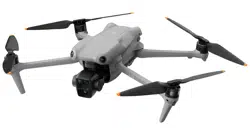Loading ...
Loading ...
Loading ...

DJI Air 3
User Manual
©
2023 DJI All Rights Reserved.
51
If the current altitude is higher than the RTH altitude, the aircraft ies to the Home Point
at the current altitude. When the aircraft is approaching the home point, the aircraft will
descend while ying forward if the current altitude is higher than the RTH Altitude.
• If the aircraft is at a distance of 5 to 50 m from the Home Point when RTH begins, the
aircraft adjusts its orientation and ies to the Home Point at the current altitude. If the
current altitude is lower than 2 m when RTH begins, the aircraft will ascend to 2 m and
les to the Home Point.
• The aircraft lands immediately if it is less than 5 m from the Home Point when RTH
begins.
4. The aircraft lands and the motors stop after reaching the Home Point.
• During Advanced RTH, the aircraft will adjust the flight speed automatically to suit
environmental factors such as wind speed and obstacles.
• The aircraft cannot avoid small or ne objects such as tree branches or power lines. Fly
the aircraft to an open area before using Smart RTH.
• Set Advanced RTH as Preset if there are power lines or towers that the aircraft cannot
bypass on the RTH path and make sure the RTH Altitude is set higher than all obstacles.
• The aircraft will brake and return to home according to the latest settings if the RTH
settings are changed during RTH.
• If the max altitude is set below the current altitude during RTH, the aircraft will descend
to the max altitude rst and then continue returning to home.
• The RTH Altitude cannot be changed during RTH.
• If there is a large difference between the current altitude and the RTH altitude, the
amount of battery power used cannot be calculated accurately due to wind speed
dierence at dierent altitudes. Pay extra attention to the battery power prompts and
warning prompts in DJI Fly.
• Advanced RTH will not be available if the lighting condition and environment are not
suitable for vision systems during takeo or RTH.
• During Advanced RTH, the aircraft will enter Straight Line RTH if the lighting condition
and environment becomes unsuitable for the vision systems. In this case, the aircraft
cannot bypass the obstacles. An appropriate RTH altitude must be set before entering
RTH.
• When the remote controller signal is normal during Advanced RTH and Straight Line
RTH, the pitch stick can be used to control the flight speed, but the orientation and
altitude cannot be controlled, and the aircraft cannot be controlled to y to the left or
right. Constantly pushing the pitch stick to accelerate will increase the battery power
consumption speed. The aircraft cannot bypass obstacles if the ight speed exceeds
the eective sensing speed. The aircraft will brake and hover in place and exit RTH if the
pitch stick is pulled all the way down. The aircraft can be controlled after the pitch stick
is released.
• If the Home Point is in the Altitude Zones while the aircraft is outside, the advanced
RTH will y the aircraft below the altitude limit, which may be lower than the set RTH
altitude. Fly with caution.
Loading ...
Loading ...
Loading ...
